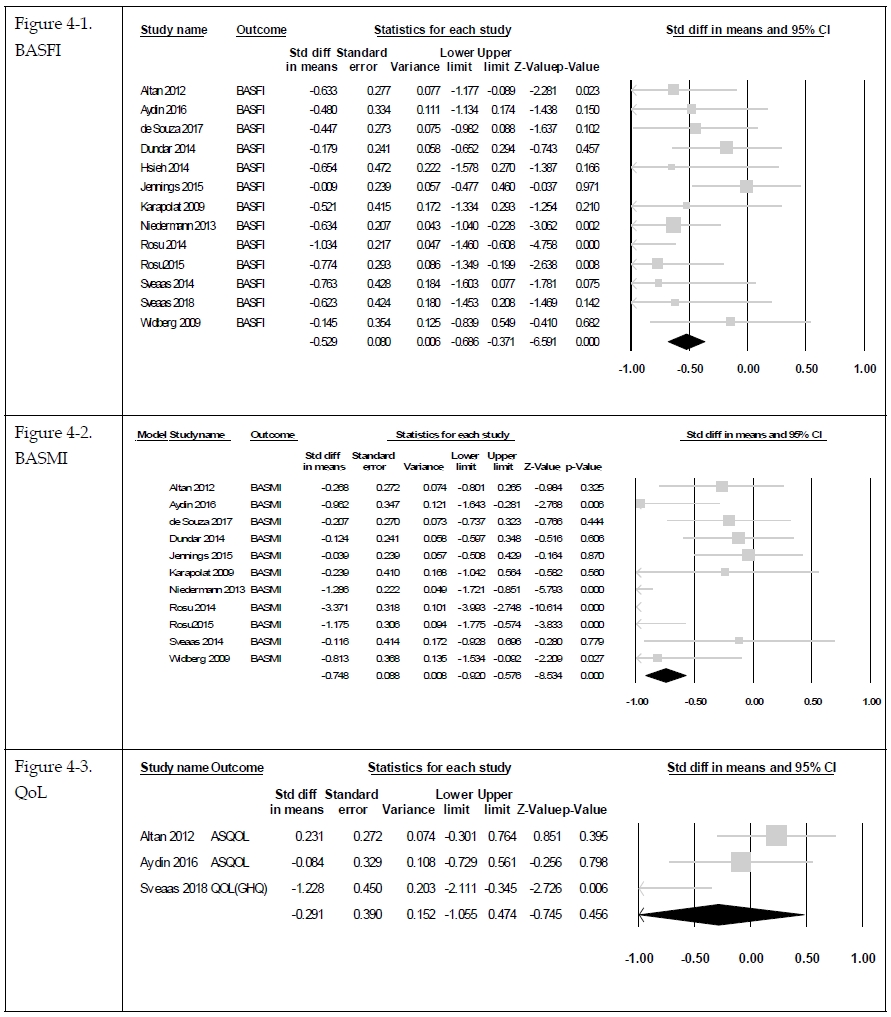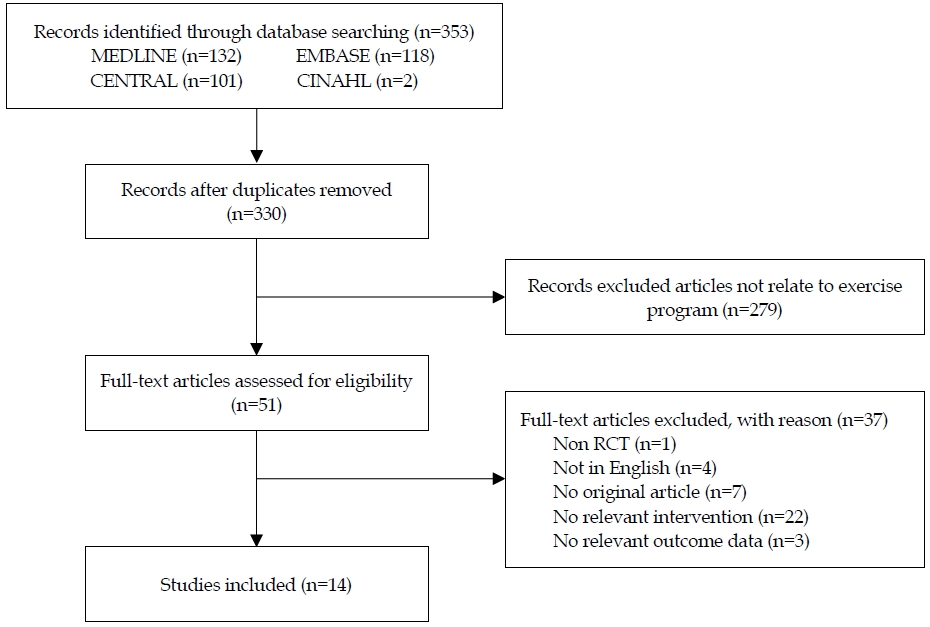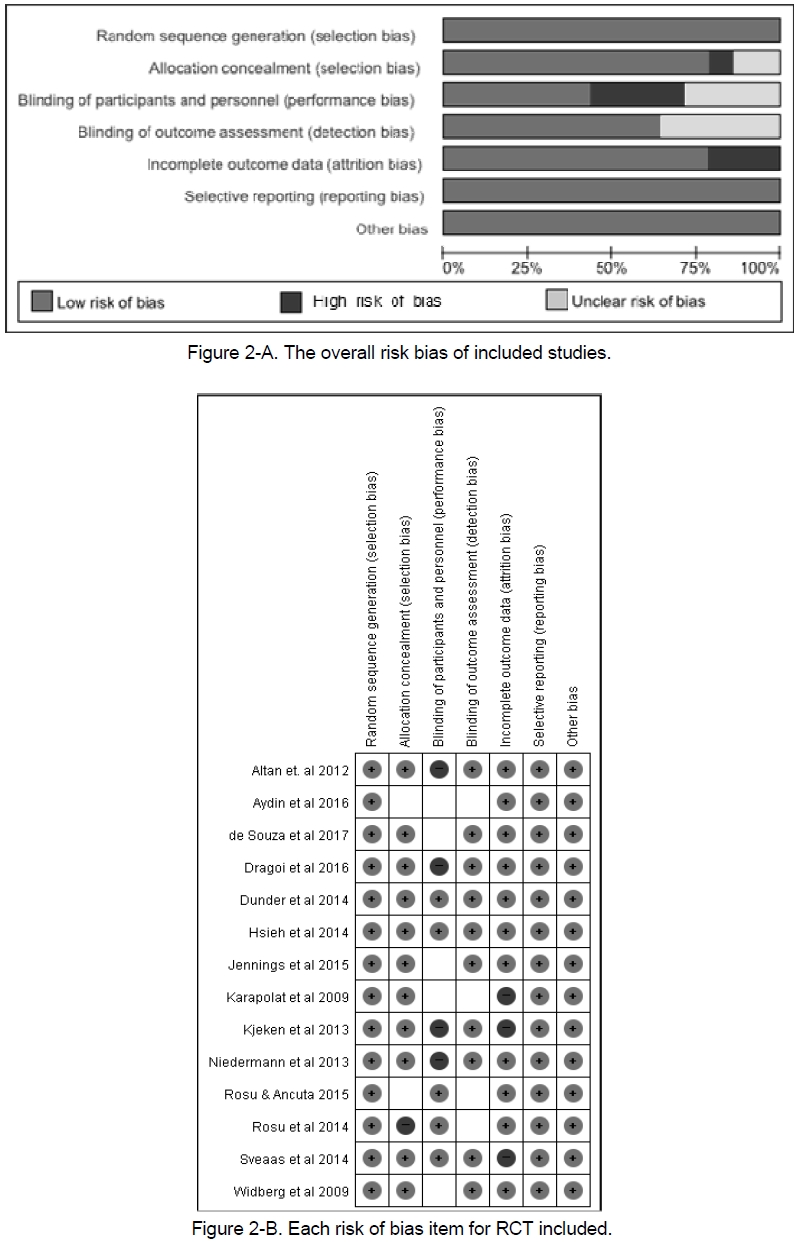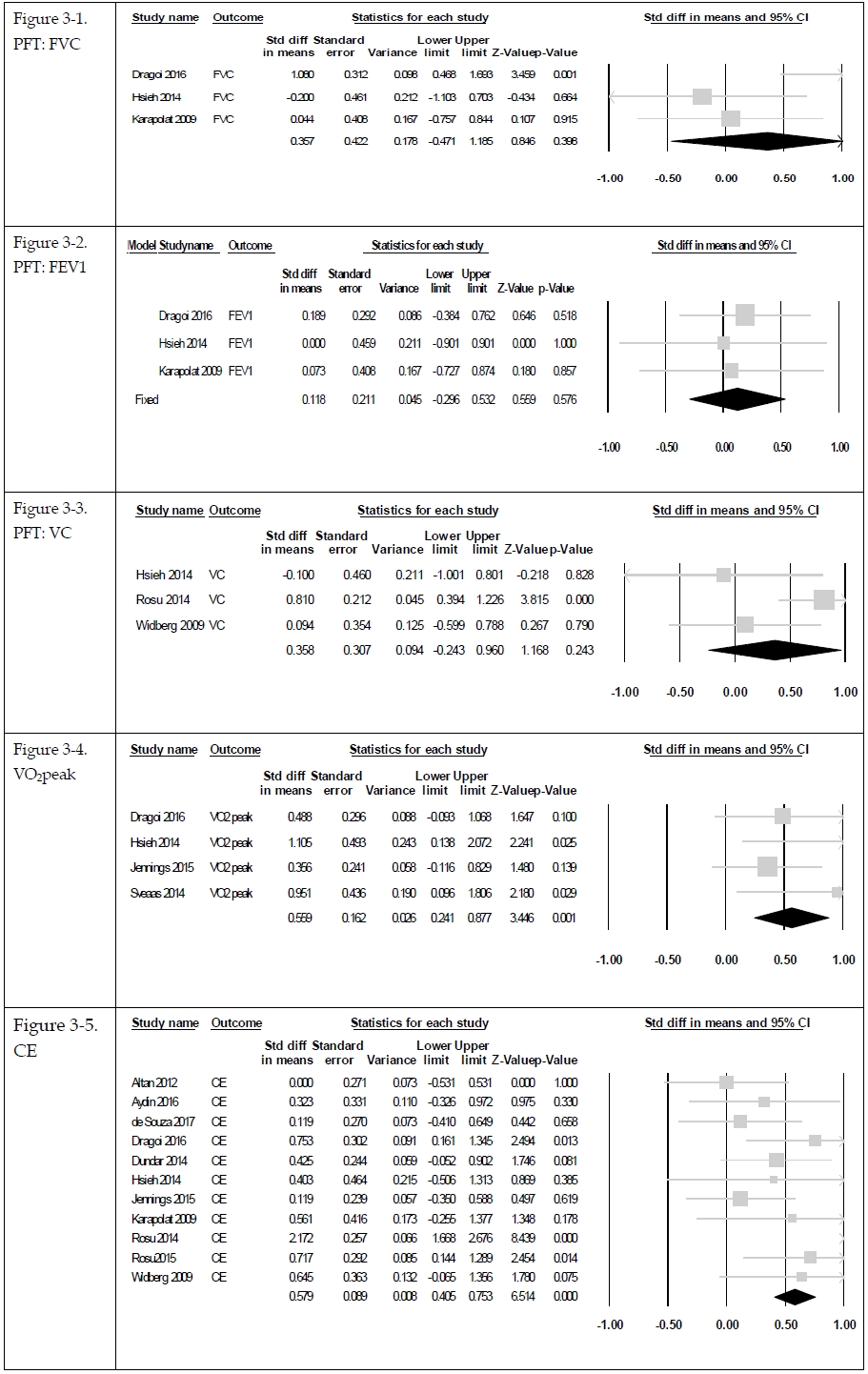
강직성 척추염 환자의 폐기능에 미치는 운동효과에 대한 메타분석
ⓒ 2019 Korean Society of Muscle and Joint Health
Abstract
This study aimed to analyze the effects of exercise on pulmonary function in patients with ankylosing spondylitis (AS).
Randomized controlled trials (RCTs) were identified by searching MEDLINE, EMBASE, CENTRAL, and CINAHL (through Jan 2019). Three reviewers independently retrieved articles, extracted data, and assessed methodological quality using the Cochrane’s Risk of Bias for randomized studies.
Fourteen studies met the inclusion criteria with a total of 729 participants. CE (SMD 0.58, 95% CI 0.41~0.75, p<.001) and VO2peak (SMD 0.56, 95% CI 0.24~0.88, p=.001) had a significant effect on the most exercise interventions. As a secondary variable, BASFI (SMD -0.53, 95% CI -0.70~-0.37, p<.001), BASMI (SMD -0.75, 95% CI -0.92~-0.58, p<.001) showed an effect size of more than medium. However, PFT and QoL did not produce a significant results.
Pulmonary involvement is common in patients with AS and might have disturbed functionality and exercise modality. Exercise can be an effective intervention to improve pulmonary function in patients with AS. More attention is needed to improve the chest and spinal mobility to maintain the appropriate pulmonary function. It is also necessary to consider how to construct a patient-tailored exercise program to increase performance, accuracy and safety of exercise.
Keywords:
Ankylosing spondylitis, Exercise, Meta-analysis키워드:
강직성 척추염, 운동, 메타분석서 론
1. 연구의 필요성
강직성 척추염은 대개 30세 정도에 발현하며, 남성에서 여성보다 약 3.4배 정도 더 많이 발생하는 류마티스성 척추 관절염이다(Braun & Sieper, 2007). 강직성 척추염의 유병률은 대상자 선별기준이나 진단기준 등에 따라 차이가 있는데, 전 세계적으로 0.1%~1.4% 정도로 추산하고 있다(Dean et al., 2014). 주로 척추의 염증과 구조적 손상에 의한 척추 부위의 강직과 운동성 감소가 특징적이며(Wanders et al., 2005), 구조적 손상뿐만 아니라 기능 손상으로 인해 결국에는 삶의 질까지도 떨어뜨린다(Braun & Sieper, 2007). 척추 부위의 강직과 운동성 감소는 흉부관절에도 영향을 끼칠 수 있기 때문에 그 결과 흉벽의 움직임 제한이 발생하면서 폐의 실질적인 기능에까지도 영향을 줄 수 있다. 하지만 폐기능에 부정적인 영향을 끼치는 정도나 관련변수들과의 관계는 연구마다 차이가 있다(Berdal, Halvorsen, van der Heijde, Mowe, & Dagfinrud, 2012; Dincer et al., 2007; Sharan & Rajkumar, 2017).
강직성 척추염의 증상을 조절하고 구조적 손상을 완화시키기 위하여 일반적으로 약물치료와 함께 척추의 운동성, 자세 그리고 신체 상태를 향상시킬 수 있는 운동기반 중재 프로그램들이 다양하게 적용되고 있다(Chang, Tsou, & Lee, 2016; Zao & Cantista, 2017). 운동기반 중재는 대체로 안전하고 신체 · 사회 · 심리적인 이점을 모두 가지고 있기 때문에 중요한 비약물치료로써 권고된다(Kelly, Kelly, & Callahan, 2018). 그래서 선행연구들에서는 운동이행을 통해 통증이나 척추를 중심으로 한 신체기능의 변화나 그에 따른 사회심리적인 상태를 확인하고 있는 경우가 많다(Dagfinrud et al., 2011). 그러나 일차적인 신체변화인 통증이나 강직과 달리 이차적인 신체변화로 볼 수 있는 호흡제한이나 폐 기능 개선에 대한 연구결과는 일관되게 보고되고 있지 않다(Karapolat et al., 2008).
이에 본 연구에서는 강직성 척추염 환자에게 운동중재를 적용한 무작위 대조군 연구를 대상으로 흉부제한으로 인한제한적 폐기능을 잘 보여줄 수 있는 폐기능검사(Pulmonary Function Test, PFT)와 흉부 확장(Chest Expansion, CE) 결과를 주요 변수로 하여 그 효과를 분석하고자 하였다. 또한 주요변수와 상관관계가 있는 것으로 알려져 있는 척추 기능 정도와 운동성 그리고 강직성 척추염 환자에 대한 운동중재의 궁극적인 목표인 삶의 질에 미치는 영향도 함께 분석하였다.
2. 연구목적
본 연구의 목적은 강직성 척추염 환자에게 운동 중재를 적용한 무작위 대조군 실험연구를 대상으로 폐기능검사와 흉부 확장에 미치는 중재효과를 체계적으로 분석하는데 있다. 2차적으로는 운동중재가 척추 기능정도와 운동성 및 삶의 질 등에 미치는 효과를 확인하고자 하였다.
연구방법
1. 연구설계
본 연구는 강직성 척추염 환자에게 적용한 운동 중재의 효과를 검증한 무작위 비교연구(Randomized Controlled Trials, RCT)결과들을 통합하고 분석하기 위한 메타분석 연구로, PRISMA (Preferred Reporting Items for Systematic Reviews and Meta-Analyses) 그룹이 제시한 체계적 문헌고찰 보고 지침에 따라 수행되었다.
2. 핵심질문
본 연구의 핵심질문을 PICO-SD (population, intervention, comparison, outcome, study design) 형식에 따라 구체적으로 제시하면 다음과 같다. 1) 연구대상(population)은 강직성 척추염 환자이며, 질환 중증도는 제한하지 않았다. 2) 본 연구의 관심 중재(intervention)는 운동 중재이다. 3) 비교 중재(comparator)는 통상적 관리(usual care)이다. 4) 운동 중재의 일차결과(primary outcomes)로 폐 기능검사 결과, 흉부 확장 결과를 선정하였으며, 이차결과(secondary outcomes)로는 척추 기능 정도와 운동성, 강직성 척추염 관련 삶의 질을 선정하였다. 5) 연구유형(study design)은 RCT로 제한하였다.
3. 자료 선정기준 및 배제기준
문헌의 선택기준은 1) 강직성 척추염 환자를 대상으로 운동 중재를 수행한 연구, 2) 운동 중재의 결과로 폐기능 또는 신체기능을 보고한 연구, 3) 무작위 배정 비교임상연구이다.
문헌의 배제기준은 1) 원저가 아닌 연구, 2) 운동효과변수로 폐기능을 보고하지 않은 연구, 3) 초록만 발표되었거나 포스터만 발표된 연구, 4) 영어로 출간되지 않은 연구이다.
연구자가 사전에 선정한 선택기준과 배제기준에 따라 PRISMA 흐름도를 사용하여 문헌을 선정하였다. 먼저, 검색엔진을 이용하여 1차 선택과정을 진행하였고, 초록 및 전문을 통해 중복된 논문을 제외하는 2차 과정을 수행하였으며, 최종으로 전문을 재검토하는 3차 선택과정을 수행하였다. 문헌검색으로 최종 문헌을 선택할 때까지 3명의 연구자가 독립적으로 평가와 분석을 시행한 후 결과를 종합하였고, 의견이 다른 경우는 토의를 통해 합의된 결과를 도출하였다.
4. 문헌검색전략
문헌검색은 전자 데이터베이스를 활용하여 2019년 1월 8일~1월 22일에 걸쳐 시행하였다. 현재 본 연구의 선정기준에 적합한 국내연구는 보고되지 않아 출판 일자의 제한 없이 국외 문헌만을 검색에 포함하였다. 검색은 MEDLINE, EMBASE, CENTRAL (Cochrane Central Register of Controlled Trials), CINAHL (Cumulative Index to Nursing and Allied Health Literature)을 활용하였다.
검색어는 Medical Subject Headings (MeSH)에서 제안한 용어를 기본으로 각 데이터베이스별 특성에 맞추어 수정하여 사용하였다. 연구대상자(participants)는 (‘Spondylitis, Ankylosing’ [MeSH] OR ‘Ankylosing Spondylarthritis’ OR ‘Ankylosing Spondylitis’ OR ‘Ankylosing Spondyloarthritis’ OR ‘Axial’OR ‘Axial Spondyloarthritis’)를 사용하였고, 중재(Exercise programs)는 다양한 형태의 운동을 모두 포함할 수 있도록(‘Exercise’ [MeSH] OR ‘Exercise Training’ OR ‘Exercise, Physical’ OR ‘Physical Activity’ OR 'Exercise Therapy’ OR ‘Physical Fitness’ OR ‘Training’ [MeSH] OR ‘Rehabilitation’)을 사용하였다(Appendix 1). 그리고 영어로 발표된 연구로 제한하였다.
5. 문헌의 비뚤림 위험평가
문헌의 비뚤림 위험은 코크란 그룹의 Risk of bias 도구(Rob 도구)를 사용하였다. RoB 도구는 RCT에 대한 비뚤림 위험평가 방법으로 체크리스트 방식과 영역평가 방식이 결합된 형태를 가지고 있다. 각 문항에 대하여 문헌의 본문에 어떠한 내용이 있는지에 따라 비뚤림 위험이 낮음(low risk of bias), 높음(high risk of bias), 불확실(unclear)로 평가한다. RoB 도구는 무작위 배정순서 생성, 배정순서 은폐, 참여자와 연구자의 눈가림, 결과 평가자의 눈가림, 불충분한 결과의 처리, 선택적 결과 보고, 타당도를 위협하는 다른 잠재적 비뚤림 위험의 7가지 영역을 평가하도록 구성되어 있다(Kim et al., 2011).
본 연구에서는 최종 선택된 문헌을 대상으로 연구자 3인이 독립적으로 평가를 시행하였으며, 의견이 일치되지 않는 경우 연구진 논의를 통해 합의된 결과를 도출하였다.
6. 자료추출 및 분석
체계적 문헌고찰에 포함된 문헌의 특성을 분석한 후 양식을 만들어 정리하였다. 양식은 저자, 출판년도, 대상자 수, 대상자 평균 연령, 중재군 특성(운동유형, 운동량 등), 대조군 특성, 일차결과, 이차결과 등을 포함하였다.
선택된 논문을 중심으로 운동 중재의 효과 크기를 파악하기 위해 Comprehensive Meta-Analysis version 2 (Biostat, Englewood, NJ, USA, 2007)를 이용하여 메타분석을 수행하였다. 강직성 척추염이 있는 환자를 위한 운동중재효과를 분석하기 위해 실험군과 대조군의 평균과 표준편차 값이 같다는 전제하에 실험 후 평균과 표준편차 값을 분석하였고, 결과로 나온 표준화된 평균차이(Standardized Mean Difference, SMD) 값을 효과 크기로 해석하였다. 효과 크기는 Lachenbruch과 Cohen (1989)의 기준에 따라 0.20 이하이면 작고, 0.50 정도면 중간, 0.80 이상이면 크다고 해석하였다
연구결과
1. 자료선정
본 연구에서는 강직성 척추염 환자에게 시행된 운동중재의 효과에 대해 평가하고자 선행연구들을 체계적으로 고찰하였다. 국외의 주요 전자 데이터베이스(MEDLINE, EMBASE, CENTRAL, CINAHL)를 통하여 총 353편이 검색되었으며, 중복된 23개 문헌은 제거하였다. 문헌선택과정은 총 330편의 문헌으로 진행되었으며, 제목과 초록 검토를 통해 1차로 51편을 선별하였다. 2차로 원문 검토과정을 통해 1차 연구가 아닌 7편, 영문으로 쓰여 지지 않은 4편, 운동중재로 부적합한 22편, 본 연구목적에 맞는 변수를 보고하지 않은 3편, 연구설계에 적합하지 않은 논문 1편을 제외하여 총 14편을 최종 논문으로 선정하였다(Figure 1, Appendix 2).
2. 최종 문헌의 비뚤림 위험평가
본 연구에서 선택된 최종 문헌 14편의 비뚤림 위험평가의 결과는 Figure 2와 같다. 배정순서 은폐 영역은 구체적인 방법에 관한 내용이 기술되지 않아 비뚤림 위험이 불확실한 연구(A2; A12)가 14.2%인 것으로 평가되었다. 연구참여자와 연구자 눈가림 영역은 35.7%(A2; A3; A7; A8; A14)로 관련내용이 기술되어 있지 않아 비뚤림 위험이 불확실하였고, 28.6%(A1; A4; A9; A10)는 비뚤림 위험이 큰 것으로 평가되었다. 평가자의 눈가림 영역은 불충분한 기술로 비뚤림 위험이 불확실한 연구(A2; A8; A11; A12)가 28.6%였다. 나머지 무작위 배정이나 선택적 보고 등에서는 비뚤림이 모두 낮은 것으로 평가되었다.
전체 14편의 RCT에 대한 비뚤림 위험평가 결과는 무작위 배정, 배정순서 은폐, 눈가림, 불충분한 결과 자료 영역에서 비뚤림의 위험이 낮은 연구가 전체의 50% 이상으로 평가되어, 평가에 포함된 RCT의 전반적인 비뚤림 위험이 낮은 것으로 나타났다(Figure 2).
3. 연구 논문의 일반적 특성
강직성 척추염 환자를 대상으로 운동 중재를 적용한 무작위실험연구에 대한 주요 특성은 Table 1과 같다. 연구에 참여한 대상자 수는 총 729명으로, 연구별로는 28~106명이었다. 대상자의 평균 나이는 중재군 25.1~50.1세, 대조군 23.0~49.9세였다. 질병이환 기간은 평균 2.5~20.6년이었다.
4. 실험군의 운동 중재의 특성
실험군의 운동중재 프로그램은 근력운동이나 지구력운동을 단독으로 적용하였거나(A1; A3; A11) 두 가지 이상의 운동유형을 혼합한 형태(A2; A4; A5; A6; A7; A8; A9; A10; A12; A13; A14)로 구성되었다. 이완 혹은 유연성 운동인 관절가동범위운동이나 스트레칭은 운동 전후 준비 · 마무리 운동으로 주로 사용되었다. 주된 운동 유형은 유연성에 근력운동이 접목되어 있는 필라테스, 맨손운동(Calisthenic), 저항밴드운동, 헥셔 운동(Heckcher training), 메켄지 운동(McKenzie training), 골반안정성(pelvic stabilization) 운동 등이거나 지구력 운동인 스위스볼 운동, 호흡근훈련, 걷기, 트레드밀 등이 있었다.
운동 프로그램은 주로 전문가 주도로 수행되었으며, 운동 빈도를 늘리기 위해 일부는 집에서도 환자들이 운동할 수 있도록 설계되어 있었다. 대조군은 평상시 활동을 유지하거나(A1; A12; A13), 유연성 위주의 전통적 방식의 운동(A2; A3; A4; A5; A6; A7; A8; A9; A10; A11; A14)을 적용하였다. 운동 횟수는 주당 2~6회였으며, 회당 운동시간은 혼합된 운동유형에 따라 다양하나 짧게는 30분에서 길게는 80분 정도로 수행되었다. 프로그램 기간은 4주에서 48개월까지 범위가 넓었으며, 그중 2편(A3; A10)을 제외한 나머지는 모두 12주 이내로 수행되었다.
5. 운동 중재의 효과
운동 중재 프로그램에 대한 일차결과로는 PFT 중 노력성 폐활량(Forced Vital Capacity, FVC), 1초간 노력성 호기량(Forced Expiratory Volume in 1 second, FEV1), 폐활량(Vital Capacity, VC), 운동 내성을 보여주는 최고산소섭취량(Peak Oxygen Consumption, VO2peak)과 흉곽 유연성을 보여주는CE를 평가하였다. 이차결과로는 대상자의 기능적 상태와 척추의 운동성을 보여주는 Bath Ankylosing Spondylitis Functional Index (BASFI)와 Bath Ankylosing Spondylitis Metrology Index (BASMI)를 보았으며, 이와 함께 심리 · 사회적인 변수로 삶의 질에 미치는 효과를 분석하였다. 동질성 검증 결과에서 이질성이 없을 경우에는 고정효과모형으로 효과크기를 산출하였으며, 이질성을 보이는 경우에는 임의모형을 이용하였다.
폐기능검사 결과인 FVC 및 FEV1을 제시한 논문은 총 3편(A4; A6; A7)으로, 총 연구대상자는 103명이었다(Figure 3). FVC를 제시한 논문은 동질성 검증결과 이질성이 높아 임의모형으로 분석하였다(I2=71.48, p=.030). 분석결과 효과 크기는 0.36 (95% CI: -0.47~1.19)으로 통계적으로 유의하지 않았다(Z=0.85, p=.398). FEV1을 제시한 논문들은 동질하였으며(I2=0, p=.934) 효과 크기가 0.12 (95% CI: -0.29~0.53)로 통계적으로 유의하지 않았다(Z=0.56, p=.576). VC를 측정한 논문은 3편은 이질성을 보였고(I2=61.04, p=.077), 총 연구대상자 수는 147명이었다. 효과 크기는 0.36 (95% CI: -0.24~0.96)으로 중간 정도의 효과였지만 통계적으로 유의하지는 않았다(Z=1.17, p=.243). 흉곽의 유연성을 보여주는 CE를 제시한 논문은 총 10편(A1; A2; A4; A5; A6; A7; A8; A10; A11; A14)으로 이질성이 높아(I2=80.47, p<.001), 임의모형으로 분석한 결과, 효과 크기는 0.58 (95% CI: 0.41~0.75)로 중간 정도의 효과가 나타났으며 통계적으로도 유의하였다(Z=6.51, p<.001). 한편 VO2peak를 제시한 논문은 4편(A4; A6; A7; A12)으로 이질성을 보이지 않았으며(I2=0, p=.424), 효과 크기는 0.56 (95% CI: 0.24~0.88)으로 중간 정도의 효과가 나타났으며 통계적으로 유의하였다(Z=3.45, p=.001).
강직성 척추염 환자의 기능적 상태를 보여주는 BASFI 결과를 제시한 논문은 13편(A1; A2; A3; A5; A6; A7; A8; A9; A10; A11; A12; A13; A14)으로, 이질성이 낮은 것으로 나타났다(I2=21.20, p=.239). 효과 크기는 -0.53 (95% CI: -0.70~-0.37)으로 중간 정도의 효과를 보였고 통계적으로 유의하였다(Z=-6.60, p<.001). 척추 운동성을 보여주는 BASMI를 측정한 논문은 총 11편(A1; A2; A3; A5; A7; A8; A9; A10; A11; A12; A14)으로 이질성이 높아(I2=90.28, p<.001), 임의모형으로 분석한 결과, 효과 크기는 -0.75 (95% CI: -0.92~-0.58)로 중간 이상의 효과를 보였고, 통계적으로도 유의하였다(Z=-8.53, p<.001). 한편 강직성 척추염 환자의 삶의 질을 분석한 논문은 총 3편(A1; A2; A9)으로 이질성이 높아(I2=74.13, p=.021) 임의모형으로 분석한 결과, 효과 크기는 -0.29 (95% CI: -1.06~0.47)로 통계적으로 유의하지 않았다(Z=-0.75, p=.456)(Figure 4).

Forest plots of the effects of exercise program; secondary outcomes.BASFI=Bath Ankylosing Spondylitis Functional Index; BASMI=Bath Ankylosing Spondylitis Metrology Index; QoL=Quality of life; ASQoL=Ankylosing spondylitis quality of life; GHQ=General health questionnaire; Favours A=Control group; Favours B=experimental group.
논 의
강직성 척추염 환자는 흉추의 염증으로 관련 관절의 점진적인 융합과 골화가 진행되어 척추후만증, 흉부 강직, 흉벽 운동의 제한이 생기게 된다(Donath & Miller, 2009; Fisher, Cawley, & Hogate, 1990). 그 결과 폐기능 저하로 이어질 수 있지만, 폐기능을 중심으로 중재 효과를 분석한 연구는 부족한 상태이다(Berdal et al., 2012; Brambila-Tapia et al., 2013; Dincer et al., 2007; Durmuş et al., 2008; Özdemyr, Inanici, & Hasçelik, 2011). 이에 본 연구에서는 강직성 척추염 환자에게 적용한 중재 중 운동이 폐기능에 미치는 효과를 평가하기 위하여 폐기능 관련 변수인 FVC, FEV1, CE와 VO2peak를 중심으로 분석하였다.
연구결과, 운동 중재는 폐 간질의 변화와 환기능력을 평가할 수 있는 FVC와 FEV1을 향상시키는 데는 유의한 효과가 나타나지 않았다. 하지만 흉부 가동성 및 폐활량과 연관성이 큰 CE와 운동내성을 보여주는 VO2peak에서는 중등도 이상의 효과크기를 보였다. 이러한 결과는 일반적으로 질환의 중증도나 폐 실질 변화를 반영하는 폐기능 수치의 변화가 없어도 흉곽 팽창과 척추 가동성 및 신체 기능성은 개선될 수 있다고 한 것(Kanathur & Lee-Chiong, 2010)과 같은 맥락으로 강직성 척추염 환자에게 운동중재가 중요함을 보여준다. 한편 PFT는 주로 폐 기능 손상 중에서도 제한적 유형(restrictive type)을 잘 보여주는 검사로(Seçkin et al., 2000), 강직성 척추염 환자 중 이 같은 소견을 보이는 환자는 41.7% 정도이기 때문에(Dincer et al., 2007) PFT 결과를 통해 운동중재 효과를 해석하는 데 제한적일 수 있다. 이를 고려하여 폐기능을 살펴볼 수 있는 변수를 다양하게 설정하고 환자의 호흡기 손상 유형 및 정도를 운동 설계에 포함시킬 필요가 있다(Karapolat et al., 2008; Millner et al., 2016).
각각의 연구에 적용한 운동 프로그램 구성을 보면 단일한 형태보다는 유연성, 근력, 유산소 운동 등을 연구목적에 따라 다양한 형태로 혼합되어 있는 것을 알 수 있다. 운동의 종류에 따라서 개인 혹은 집단운동을 한다거나, 운동교육 및 지도 면에서 전문가 혹은 이를 집에서도 지속적으로 이행할 수 있도록 하는 방법 등으로 프로그램에 차이를 보였다. 이는 아직까지 표준화된 운동 프로토콜이 없는 상황에서, 단일한 운동보다는 다양한 형태로 혼합된 프로그램을 구성하는 것이 보다 더 효과가 좋다는 선행연구결과(Hsieh et al., 2014; Karapolat et al., 2008; Rosu, Topa, Chirieac, & Ancuta, 2014)를 반영한 것으로도 해석된다. 일관된 형태의 운동중재 프로그램을 찾기가 어렵다는 것은 이질성 없이 일관된 연구결과를 얻는 것 역시 제한점이 발생할 수 있음을 보여주는 결과이므로 향후 지속적인 연구를 통해 표준화된 운동프로토콜의 개발이 필요할 것이다.
메타분석결과에서 대체로 효과크기가 작았던 운동중재 프로그램은 가벼운 정도의 유산소운동이나 근력운동 예를 들어 걷기(Jennings, Oliveira, De Souza, Cruz, & Natour, 2015)나 필라테스(Altan, Korkmaz, Dizdar, & Yurtkuran, 2012) 등을 단순하게 적용한 것이었다. 반대로 Rosu 등(2014)은 요추와 골반의 가동성 및 안정성뿐만 아니라 호흡 관련 신체 부위(팔, 상지, 목, 몸통 등)를 직접 신전시키고 자극을 줄 수 있도록 필라테스, 헥셔 운동, 메켄지 운동 이 세 가지 운동유형을 혼합하여 적용한 결과, 효과크기가 타 연구들에 비하여 상대적으로 크게 나타났다. 흉부유연성과 척추안정성 운동 그리고 호흡운동이 혼합된 정도에 따라 영향 받은 것으로(Dundar et al., 2014; Karapolat et al., 2009; Nidermann et al., 2013; Rosu et al., 2014; Rosu & Ancuta, 2015) 강직성 척추염 환자에게 지구력 기반의 복합 운동 프로그램을 구성할 때 호흡운동을 강화시킬 수 있는 운동을 포함할 경우 그 유용성이 더 높아질 수 있을 것이다. 하지만 한편으로는 이 때문에 본 연구결과의 이질성이 대체로 높아지게 되는 원인으로 작용할 가능성이 있으므로 차후 무작위 대조군 연구결과가 좀 더 축적된다면 세부 운동유형별로 재분석을 해 볼 필요성이 있을 것으로 보인다.
강직성 척추염에서 보이는 관절강직 및 운동성의 제한은 결국 척추 주변 관절의 기능을 점차 감소시키기 때문에 운동중재의 주요 초점은 척추와 흉부의 유연성 개선과 유지라고 할 수 있다(Dagfinrud et al., 2011; Karapolat et al., 2008). 이를 본 연구에서는 환자의 기능적 상태와 척추 가동성을 보여주는 BASFI와 BASMI 결과로 분석해본 결과, 운동 중재가 중간 이상의 유의한 효과크기를 보여 비가역적인 강직과 그로 인한 신체의 기능적 손실을 줄이는 데 유용한 것을 알 수 있었다. 그러나 앞서 분석한 1차 변수와 함께 고려해보면, 운동을 통해 흉벽과 척추 가동성은 향상된다 하더라도 폐 실질의 환기기능 자체의 개선은 다소 부족할 수 있는 것으로 해석된다. 따라서 운동중재는 강직성 척추염 그 자체의 중증도를 개선하는 것은 어렵지만, 운동을 통해 흉부와 척추 주변 부위를 강화시킴으로써 가동성을 증진시킬 수 있다면 환자들이 일상생활에서 기능적으로 활동하는 것은 향상될 수 있음을 시사한다(Şahin et al., 2004).
한편 본 연구에서는 운동중재가 질환으로 인한 기능적 상태 개선에는 유의한 효과를 나타냈으나, 삶의 질 향상에는 유의한 효과를 보이지 않았다. 이러한 결과는 연구들마다 차이를 보인다. Aytekin 등(2011)은 BASMI와 BASFI 정도가 불안 및 우울과 유의한 상관관계를 가지고 있으며, 강직성 척추염으로 인한 기능적 상태의 악화와 부정적인 감정 요인은 일상활동의 감소를 가져오고 이는 결국 삶의 질을 떨어뜨리는 결과를 가져올 수 있다고 하였다(Buyukavci, Sag, Ozkarafakili, & Kuran, 2017; Dincer et al., 2007). 이 때 운동을 수행함으로써 강직성 척추염 환자들의 활력이 증가하고 통증(Karapolat et al., 2008)과 불안이 감소될 수 있으며(Kucukdeveci et al., 2000), 고강도의 운동은 정서적 고통과 피로경감에도 효과가 있다고 한 연구결과(Sveaas, Berg, Fongen, Provan, & Dagfinrud, 2018)와는 대조되는 결과이다. 운동중재를 통해 삶의 질에까지 의미 있는 영향을 끼치려면 하루 30분 이상 일주일에 적어도 5일 동안의 규칙적인 운동이 필요하며, 특히 운동을 시작한지 3개월이 지난 시점에서부터 유의한 효과가 나타난다고 한 점(Aytekin et al., 2011)을 고려해보면, 본 연구 분석에 포함된 연구들의 중재기간이 대부분 12주 이내로 비교적 짧았던 것이 하나의 원인으로 작용한 것으로 생각된다. 덧붙여 운동중재 프로그램 내용이 사회 · 심리적인 부분보다는 신체적 측면의 향상에 중점을 두었기 때문에 삶의 질에 미치는 효과가 유의하지 않았을 수도 있으므로 이에 대한 연구가 좀 더 필요할 것으로 보인다.
본 연구결과, 근력 혹은 지구력 운동으로 구성된 혼합형의 운동 프로그램이 강직성 척추염 환자의 폐 기능 및 흉곽의 움직임을 개선하고, 신체적 기능 상태와 척추의 유연성을 증진하는데 도움을 주는 것으로 나타났다. 하지만 폐 환기능력이나 삶의 질에 미치는 효과는 유의하지 않았다. 한편 혼합된 운동 프로그램의 효과는 유의하였으나, 각 연구마다 제시하는 운동 프로토콜은 일관성이 떨어져 강직성 척추염 환자 치료의 효율성과 장기적인 측면에서의 관리전략으로 활용하는데 제한이 있을 수 있다. 따라서 연구자 혹은 환자들이 손쉽게 활용할 수 있게 운동중재 프로그램을 표준화하는 작업이 추후 필요하다. 또한 운동효과를 더욱 증진시키기 위해서 질환의 진행단계와 운동 목표에 따라 운동유형을 설정하고, 변화하는 환자상태에 맞추어 운동량을 조정하여 수행할 수 있도록 도움을 주어야 할 것이다(Shim, 2009).
아직까지 강직성 척추염에 대한 운동중재 프로그램 적용 논문 중 무작위대조실험연구설계가 많지 않고, 강직성 척추염의 중증도와 질병 기간, 운동 중재 프로그램의 유형, 중재 적용 기간, 추후 평가 시기 등이 매우 다양하여 결과 해석에 제한점이 있을 수 있다. 따라서 이를 고려한 추가적인 연구가 필요하며, 임상 적용 시 이에 대한 고려가 필요하다.
결 론
본 메타분석에 포함된 운동 프로그램은 강직성 척추염 환자의 폐기능을 보여주는 흉부확장과 최대산소섭취량 개선 및 척추 유연성과 가동성을 향상시키는데 효과적인 것으로 나타났다. 그러나 메타분석에 포함된 연구물들의 이질성을 고려하여 결과 해석이나 실무 적용에 주의해야 할 것이다. 결론적으로 강직성 척추염 환자의 흉부유연성과 척추 안정성 그리고 호흡기능을 향상시키기 위해 혼합 형태의 운동중재 프로그램을 적극 권장할 필요가 있으며, 강직성 척추염 환자의 삶의 질을 향상시키기 위해서는 신체적인 측면 외에도 사회심리적인 측면을 고려한 중재를 적용해 볼 것을 제언한다.
Acknowledgments
- 본 연구는 동아대학교 연구비 지원을 받아 수행됨.
- This work was supported by the Dong-A University research fund.
References
-
Aytekin, E., Caglar, N. S., Ozgonenel, L., Tutun, S., Demiryontar, D. Y., & Demir, S. E., (2011), Home-based exercise therapy in patients with ankylosing spondylitis: Effects on pain, mobility, disease activity, quality of life, and respiratory functions, Clinical Rheumatology, 31(1), p91-97.
[https://doi.org/10.1007/s10067-011-1791-5]

-
Berdal, G., Halvorsen, S., van der Heijde, D., Mowe, M., & Dagfinrud, H., (2012), Restrictive pulmonary function is more prevalent in patients with ankylosing spondylitis than in matched population controls and is associated with impaired spinal mobility: A comparative study, Arthritis Research & Therapy, 14(1), R19.
[https://doi.org/10.1186/ar3699]

-
Brambila-Tapia, A. J. L., Rocha-Muñoz, A. D., Gonzalez-Lopez, L., Vázquez-Del-Mercado, M., Salazar-Páramo, M., Dávalos-Rodríguez, I. P., et al. , (2013), Pulmonary function in ankylosing spondylitis: Association with clinical variables, Rheumatology International, 33(9), p2351-2358.
[https://doi.org/10.1007/s00296-013-2723-2]

-
Braun, J., & Sieper, J., (2007), Ankylosing spondylitis, Lancet, 369(9570), p1379-1390.
[https://doi.org/10.1016/S0140-6736(07)60635-7]

-
Buyukavci, R., Sag, S., Ozkarafakili, M., & Kuran, B., (2017), The effects of respiratory functions on disease activity, functionality, spinal mobility and quality of life in patients with ankylosing spondylitis. Medicine Science|, International Medical Journal, 6(1), p1-72.
[https://doi.org/10.5455/medscience.2016.05.8525]

- Chang, W., Tsou, Y. M., & Lee, C., (2016), Comparison between specific exercises and physical therapy for managing patients with ankylosing spondylitis: A meta-analysis of randomized controlled trials, International Journal of Clinical and Experimental Medicine, 9(9), p17028-17039.
-
Dagfinrud, H., Halvorsen, S., Vøllestad, N. K., Niedermann, K., Kvien, T. K., & Hagen, K. B., (2011), Exercise programs in trials for patients with ankylosing spondylitis: Do they really have the potential for effectiveness?, Arthritis Care & Research, 63(4), p597-603.
[https://doi.org/10.1002/acr.20415]

-
Dean, L. E., Jones, G. T., MacDonald, A. G., Downham, C., Sturrock, R. D., & Macfarlane, G. J., (2014), Global prevalence of ankylosing spondylitis, Rheumatology, 53(4), p650-657.
[https://doi.org/10.1093/rheumatology/ket387]

-
Dincer, U., Cakar, E., Kiralp, M. Z., Bozkanat, E., Kilac, H., & Dursun, H., (2007), The pulmonary involvement in rheumatic diseases: Pulmonary effects of ankylosing spondylitis and its impact on functionality and quality of life, The Tohoku Journal of Experimental Medicine, 212(4), p423-430.
[https://doi.org/10.1620/tjem.212.423]

-
Donath, J., & Miller, A., (2009), Restrictive chest wall disorders, Seminars in Respiratory and Critical Care Medicine, 30(3), p249-251.
[https://doi.org/10.1055/s-0029-1222441]

-
Durmuş, D., Alayl, G., Uzun, O., Tander, B., Cantürk, F., Bek, Y., et al. , (2008), Effects of two exercise interventions on pulmonary functions in the patients with ankylosing spondylitis, Joint Bone Spine, 76(2), p150-155.
[https://doi.org/10.1016/j.jbspin.2008.06.013]

-
Fisher, L. R., Cawley, M. I., & Holgate, S. T., (1990), Relation between chest expansion, pulmonary function, and exercise tolerance in patients with ankylosing spondylitis, Annals of the Rheumatic Diseases, 49(11), p921-925.
[https://doi.org/10.1136/ard.49.11.921]

-
Kanathur, N., & Lee-Chiong, T., (2010), Pulmonary manifestations of ankylosing spondylitis, Clinics in Chest Medicine, 31(3), p547-554.
[https://doi.org/10.1016/j.ccm.2010.05.002]

-
Karapolat, H., Akkoc, Y., Sarı, İ., Eyigor, S., Akar, S., Kirazlı, Y., et al. , (2008), Comparison of group-based exercise versus home-based exercise in patients with ankylosing spondylitis: Effects on bath ankylosing spondylitis indices, quality of life and depression, Clinical Rheumatology, 27(6), p695-700.
[https://doi.org/10.1007/s10067-007-0765-0]

-
Kelley, G. A., Kelley, K. S., & Callahan, L. F., (2018), Community-deliverable exercise and anxiety in adults with arthritis and other rheumatic diseases: A systematic review with meta-analysis of randomized controlled trials, BMJ Open, 8(2), pe019138.
[https://doi.org/10.1136/bmjopen-2017-019138]

- Kim, S. Y., Park, J. E., Seo, Y. J., Jang, B. H., Son, H. J., Suh, H. S., et al. , (2011), NECA's guidance for undertaking systematic reviews and meta-analyses for intervention, Seoul, National Evidence-based Health Care Collaborating Agency.
- Kucukdeveci, A. A., McKenna, S. P., Kutlay, S., Gursel, Y., Whalley, D., & Arasil, T., (2000), The development and psychometric assessment of the Turkish version of the Nottingham Health Profile, International Journal of Rehabilitation Research, 23, p31-38.
-
Lachenbruch, P. A., & Cohen, J., (1989), Statistical Power Analysis for the Behavioral Sciences (2nd ed.), Journal of the American Statistical Association, 84(408), p1096.
[https://doi.org/10.2307/2290095]

-
Millner, J., Barron, J. S., Beinke, K. M., Butterworth, R. H., Chasle, B. E., Dutton, L. J., et al. , (2016), Exercise for ankylosing spondylitis: An evidence-based consensus statement, Seminars in Arthritis and Rheumatism, 45(4), p411-427.
[https://doi.org/10.1016/j.semarthrit.2015.08.003]

- Özdemyr, O., Inanici, F., & Hasçelik, Z., (2011), Reduced vital capacity leads to exercise intolerance in patients with ankylosing spondylitis, European Journal of Physical and Rehabilitation Medicine, 47(3), p391-397.
-
Şahin, G., Çalikoğlu, M., Özge, C., İncel, N., Biçer, A., Ulşubaş, B., et al. , (2004), Respiratory muscle strength but not BASFI score relates to diminished chest expansion in ankylosing spondylitis, Clinical Rheumatology, 23(3), p199-202.
[https://doi.org/10.1007/s10067-003-0850-y]

- Seçkin, U., Bölükbasi, N., Gürsel, G., Eröz, S., Sepici, V., & Ekim, N., (2000), Relationship between pulmonary function and exercise tolerance in patients with ankylosing spondylitis, Clinical and Experimental Rheumatology, 18(4), p503-506.
-
Sharan, D., & Rajkumar, J. S., (2017), Physiotherapy for ankylosing spondylitis: Systematic review and a proposed rehabilitation protocol, Current Rheumatology Reviews, 13(2), p121-125.
[https://doi.org/10.2174/1573397112666161025112750]

- Shim, J., (2009), Effectiveness of exercise therapy on physical function in patients with ankylosing spondylitis: Systemic review and meta-analysis, Physical Therapy Korea, 16(3), p50-59.
-
Sveaas, S. H., Berg, U., Fongen, C., Provan, S. A., & Dagfinrud, H., (2018), High-intensity cardiorespiratory and strength exercises reduced emotional distress and fatigue in patients with axial spondyloarthritis: A randomized controlled pilot study, Scandinavian Journal of Rheumatology, 47(2), p117-121.
[https://doi.org/10.1080/03009742.2017.1347276]

-
Wanders, A., Landewé, R., Dougados, M., Mielants, H., van der Linden, S., & van der Heijde, D., (2005), Association between radiographic damage of the spine and spinal mobility for individual patients with ankylosing spondylitis: Can assessment of spinal mobility be a proxy for radiographic evaluation?, Annals of the Rheumatic Diseases, 64(7), p988-994.
[https://doi.org/10.1136/ard.2004.029728]

-
Zão, A., & Cantista, P., (2017), The role of land and aquatic exercise in ankylosing spondylitis: A systematic review, Rheumatology International, 37(12), p1979-1990.
[https://doi.org/10.1007/s00296-017-3829-8]

Appendix
Appendix 1. Carbon Emission of Labeled Interior Products
Appendix 2. List of Studies included in a Systematic Review















